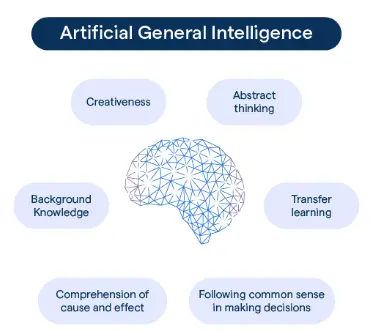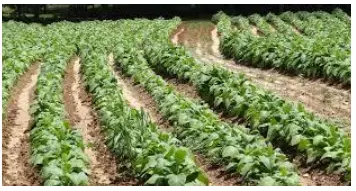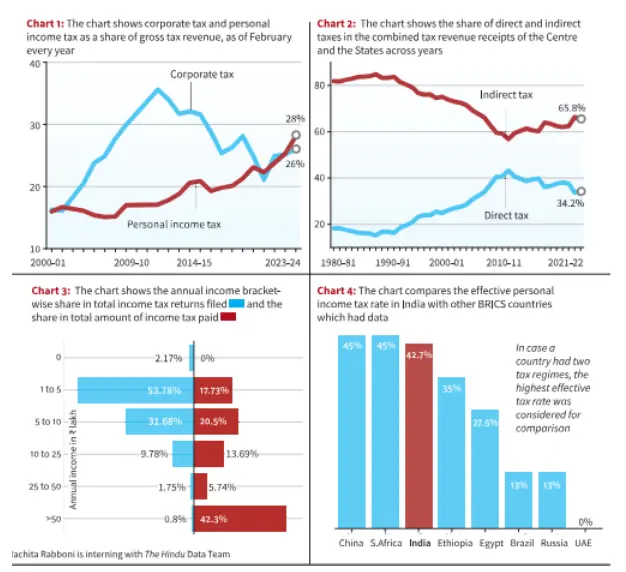Saturday, 11th May 2024
Requirement for a Fresh Agricultural Export-Import Policy
In News: In the fiscal year ending March 31, 2024, India's agricultural exports experienced a notable decline of 8.2%. This decrease can be attributed to restrictions imposed on shipments of various commodities, ranging from cereals to sugar and onions.

Overview of India's Agricultural Scenario
- Growth Rate and Contribution
- According to the second advance estimates, India's agriculture and allied sector is projected to grow by 0.7% in FY24.
- The agricultural sector is estimated to constitute 18 percent of India's Gross Value Added (GVA) in FY24.
- Production
- Total food grains production for FY23 reached 329.7 million tonnes, marking a rise of 14.1 million tonnes compared to the previous year.
- Horticulture production reached a record high of 355.25 million tonnes, as per third advance estimates.
- India holds global dominance in agricultural commodities, being the largest producer of milk, pulses, and spices worldwide.
- Additionally, it ranks as the second-largest producer of various other agricultural products.
Analysis of Agricultural Export
- Statistics
- The total value of farm exports was $48.82 billion in 2023-24, a decline from the previous fiscal years.
- Trends Over Years
- Initial years of the present government saw a decline in agricultural exports due to falling global prices.
- The UN Food and Agriculture Organization’s food price index dropped significantly during this period.
- Impact of Global Events
- Global price recovery post-Covid-19 pandemic and Russia’s invasion of Ukraine led to peaks and troughs in India's farm exports.
- Agri Exports: Key Trends
- Export restrictions on sugar and non-basmati rice led to declines in their export values.
- Wheat and onion exports faced bans, affecting their trade values.
- Basmati rice and spices exports witnessed growth.
- Agri Imports: Key Trends
- Overall agri imports decreased, mainly due to lower imports of edible oils.
- However, imports of pulses nearly doubled in 2023-24.
Key Takeaways
- Policy stability and predictability are crucial for farmers and agri-traders.
- Overnight bans on exports can disrupt markets and hurt producers.
- Building export markets requires time and effort, necessitating predictable policies.
- Low import duties contradict objectives of crop diversification, particularly for pulses and oilseeds.
Source: IE
Guidelines For Dietary Requirements of Vulnerable Population
In News: The National Institute of Nutrition (NIN), India's premier nutrition research institute, has released comprehensive guidelines addressing the dietary needs of vulnerable groups, specifically targeting pregnant and lactating women, children, and the elderly.
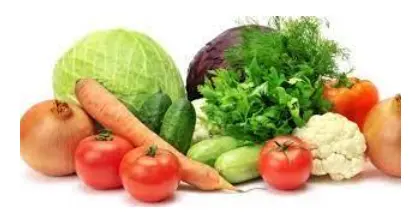
Understanding Noncommunicable Diseases (NCDs)
- Definition and Types
- Noncommunicable Diseases (NCDs), also known as chronic diseases, are characterized by their long duration and are influenced by a combination of genetic, physiological, environmental, and behavioral factors.
- The main types of NCDs include cardiovascular diseases (CVDs), cancers, chronic respiratory diseases (CRDs), and diabetes.
- Global Impact of NCDs
- NCDs disproportionately affect individuals in low- and middle-income countries, with over three-quarters of global NCD deaths occurring in these regions, totaling 31.4 million deaths.
- The global ambition, as per Sustainable Development Goal 3, is to reduce premature mortality from NCDs by one-third by 2030.
Status of NCDs in India
- According to the "India: Health of the Nation's States" report by the Indian Council of Medical Research (ICMR), the proportion of deaths due to NCDs in India has increased from 37.9% in 1990 to 61.8% in 2016, further rising to 63% of all deaths.
- Individuals over 30 years old are most severely impacted by NCDs, with CVDs being the leading cause of NCD-related deaths at 27%, followed by CRDs (11%), cancers (9%), diabetes (3%), and others (13%).
- Behavioral risk factors such as unhealthy diet, lack of physical activity, and tobacco and alcohol use contribute to the prevalence of NCDs.
- NCDs are expected to result in a loss of $3.55 trillion in economic output for India between 2012 and 2030.
Initiatives to Address NCDs in India
- Rebranding and expanding the National Program for Prevention and Control of Cancer, Diabetes, CVDs & Stroke (NPCDCS) into the National Programme for Prevention and Control of NCDs (NP-NCD), which now includes additional diseases such as Chronic Obstructive Pulmonary Disease (COPD) and Asthma, Chronic Kidney Disease (CKD), and Non-Alcoholic Fatty Liver Disease (NAFLD).
- Revision of operational guidelines for NP-NCD, emphasizing primary and secondary prevention to improve the quality of care services.
- The aim to provide standard care to 75 million people with hypertension and diabetes by 2025, making it the largest coverage of NCDs in primary healthcare.
- Initiatives by the National Institute of Nutrition (NIN), including comprehensive guidelines on the diet of vulnerable groups, focusing on addressing dietary deficiencies and promoting healthy nutrition practices.
Challenges and Recommendations
- India faces a dual nutrition challenge, with both micronutrient deficiencies and diseases of overnutrition prevalent.
- Recommendations include diversifying diets to include a variety of nutrient-rich foods, limiting consumption of processed and unhealthy foods, and age-specific dietary guidelines for pregnant women, infants, children, and the elderly.
Source: IE
Market-Based Approaches to Forest Conservation
In News: A recent review by IUFRO found that market-based forest conservation methods like carbon offsets and deforestation-free certifications have largely failed to protect trees or reduce poverty.
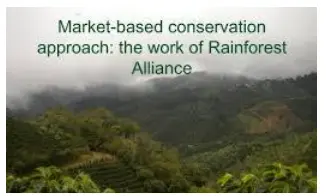
Key Findings of the Recent Study
- Global Study Conclusions
- A global study conducted across 120 countries found that trade and finance-driven initiatives had made "limited" progress in halting deforestation and sometimes exacerbated economic inequality.
- The report suggests a need for a "radical rethink" of market-based approaches due to persisting poverty and forest loss in regions where such mechanisms have been dominant for decades.
- Examples from countries like the Democratic Republic of Congo, Malaysia, and Ghana demonstrate instances where market-based projects failed to benefit local communities or halt deforestation.
- Complex and overlapping market-based schemes are on the rise, with financial actors prioritizing short-term profits over sustainable forest governance.
- Concerns Raised by the Study
- The study raises concerns about the potential negative consequences of wealthy nations' green trade policies on developing countries if not properly implemented.
- It highlights the significance of the findings and recommendations for policymakers and stakeholders in the field of forest conservation, with plans to present the report at a high-level UN forum.
Market-Based Approaches to Forest Conservation
- Overview
- Traditionally, forest conservation relied on regulations and government intervention.
- Market-based approaches assign value to the environmental benefits of forests and create mechanisms for individuals to profit from protecting them.
- Examples of Market-Based Approaches
- Carbon Offsets: Companies invest in projects that protect forests to offset their carbon emissions.
- Payments for Ecosystem Services (PES): Landowners receive payments for the environmental services their forests provide, such as clean water or biodiversity habitat.
- Deforestation-Free Certification: Independent verification ensures products come from sustainably managed forests, allowing consumers to choose forest-friendly options.
Impacts of Market-Based Approaches (MBAs) to Forest Conservation
- Positives
- Incentivize Conservation: Economic value motivates landowners to preserve forests.
- Market Efficiency: Allows the market to find cost-effective conservation methods.
- Promote Sustainable Practices: Rewards sustainable practices over deforestation.
- Negatives
- Unequal Benefits: Can exacerbate existing inequalities.
- Monitoring Challenges: Weak monitoring can lead to greenwashing.
- Uncertain Long-Term Impact: Long-term effectiveness is still being evaluated.
Way Forward
- Empower local communities through land tenure rights and participation in decision-making.
- Implement clear regulations and robust enforcement alongside market-based approaches.
- Design equitable benefit-sharing mechanisms prioritizing local communities.
- Invest in effective monitoring systems to prevent greenwashing and ensure genuine conservation outcomes.
Conclusion
Market-based approaches are valuable tools in forest conservation but must be implemented cautiously alongside other strategies. The study emphasizes the need to prioritize community-driven solutions, strengthen regulations, and promote equity for the long-term protection of vital forests and the well-being of dependent communities.
|
UPSC Previous Year Questions Prelims (2011) Q. Regarding “carbon credits”, which one of the following statements is not correct? (a) The carbon credit system was ratified in conjunction with the Kyoto Protocol (b) Carbon credits are awarded to countries or groups that have reduced greenhouse gases below their emission quota (c) The goal of the carbon credit system is to limit the increase of carbon dioxide emission (d) Carbon credits are traded at a price fixed from time to time by the United Nations Environment Programme. Ans: (d) Mains (2014) Q. Should the pursuit of carbon credits and clean development mechanisms set up under UNFCCC be maintained even though there has been a massive slide in the value of a carbon credit? Discuss with respect to India’s energy needs for economic growth. |
Source: BT
Land Subsidence in Chenab Valley
In News: In recent times, incidents of land subsidence have been reported in various areas of the Chenab Valley, notably in the districts of Ramban, Kishtwar, and Doda. These occurrences have resulted in the destruction of numerous houses and structures.
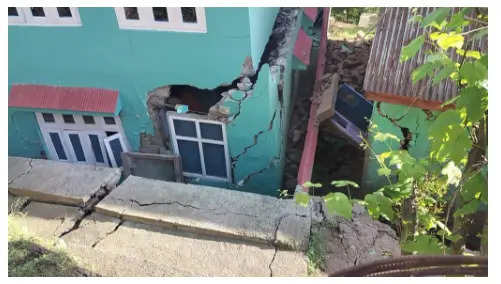
Understanding Land Subsidence
- Definition and Causes
- Land subsidence refers to the sinking of the ground due to movement of underground materials, caused by various factors, both natural and human-induced.
- Factors contributing to land subsidence include the extraction of underground resources, such as water, oil, and natural gas, as well as mining activities, earthquakes, soil erosion, and soil compaction.
- Major Causes of Land Subsidence
- Overexploitation of Underground Resources: Extraction of resources like water, natural gas, and oil reduces pore pressure and increases effective stress, leading to ground subsidence. Notably, irrigation and agricultural practices contribute to over 80% of extracted water globally.
- Extraction of Solid Minerals: Mining activities, particularly coal mining, create empty spaces underground (goaf), contributing to ground subsidence.
- Load Exerted on Ground: The construction of tall buildings and heavy infrastructure can exert pressure on the ground, causing soil deformation and subsidence. Additionally, continuous soil creep, a gradual downhill movement of soil due to gravity, can also lead to subsidence over time.
- Examples of Land Subsidence
- Jakarta, Indonesia: Excessive groundwater extraction has led to severe land subsidence, with the city sinking at a rate of 25 cm per year.
- Netherlands: Land subsidence is a significant issue due to natural gas extraction from underground reservoirs.
- Reasons for Land Subsidence in the Chenab Region
- Geological Factors: Soft sedimentary deposits and alluvial soils in the region are prone to compaction under the weight of overlying structures and external forces like groundwater extraction.
- Unplanned Constructions and Urbanization: Rapid urbanization and unplanned construction activities in hilly regions exert immense pressure on the land, contributing to subsidence.
- Hydroelectric Projects: Construction of hydroelectric stations can alter water flow patterns and impact land stability.
- Poor Drainage Systems: Inadequate drainage worsens subsidence by causing waterlogging, increased groundwater levels, soil erosion, and infrastructure damage.
- Geological Vulnerability: The presence of scattered rocks covered with old landslide debris, with low bearing capacity, exacerbates subsidence risks.
Strategies for Mitigation and Prevention
- Sustainable and Regional Development Plan
- Prioritize environmental preservation while developing the Himalayan region, focusing on responsible utilization of natural resources.
- Implement efficient water management practices like rainwater harvesting to reduce groundwater extraction.
- Continuous Seismic Monitoring and Early Warning Systems
- Establish monitoring networks to track ground movements and seismic activity, enabling early detection of subsidence and earthquake-related hazards.
- Utilize satellite technology and ground-level scientific studies for continuous monitoring.
- Regulating Mining and Resource Extraction
- Enforce strict regulations on mining activities to prevent the creation of underground voids, thereby mitigating subsidence risks.
- Climate Change Mitigation
- Address climate change by reducing greenhouse gas emissions and promoting sustainable practices to slow down glacial melting and associated subsidence.
These measures are crucial for safeguarding the environment and communities in the Chenab region against the adverse impacts of land subsidence.
|
UPSC Previous Year Questions Prelims (2021) Q. Which one of the following ancient towns is well known for its elaborate system of water harvesting and management by building a series of dams and channelizing water into connected reservoirs? (a) Dholavira Ans: (a) Prelims (2021) Q.2 With reference to ‘Water Credit’, consider the following statements:
Which of the statements given above are correct? (a) 1 and 2 only Ans: (c) Mains (2013) Q. Bring out the causes for more frequent landslides in the Himalayas than in Western Ghats. Mains (2021) Q. Describe the various causes and the effects of landslides. Mention the important components of the National Landslide Risk Management Strategy. |
Source: DTE
Foot Rot Disease
In News: Ludhiana's Punjab Agricultural University has introduced Trichoderma asperellum, a biocontrol agent, to address foot rot disease in Basmati rice varieties. It has been registered with the Central Insecticides Board and Registration Committee (CIBRC).
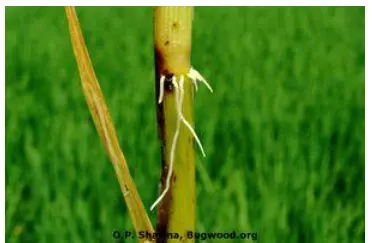
Understanding Foot Rot Disease in Basmati Rice Crops
- Foot Rot Disease is a fungal infection predominantly affecting Basmati rice crops, particularly during the seedling stage and post-transplantation if infected seedlings are used.
- The disease is caused by the soil-seed borne pathogen Fusarium verticillioides, which spreads through the plant's roots, eventually colonizing the stem base.
- Infected seedlings exhibit symptoms such as pale yellowing, elongation, drying up, and eventual death.
- Current management practices involve treating seedlings with Trichoderma harzianum before sowing and transplantation, along with seed treatment using fungicides like Sprint 75 WS (carbendazim + mancozeb). However, these chemical treatments pose risks to soil health and can be harmful to consumers due to residues.
- Trichoderma asperellum is a biocontrol agent providing a non-chemical alternative for disease management, minimizing environmental impacts.
Source: IE
Batagay Crater
In News: A recent study reveals that a massive crater within Siberia's permafrost is expanding at a rate of 35 million cubic feet annually due to the thawing of the frozen ground.
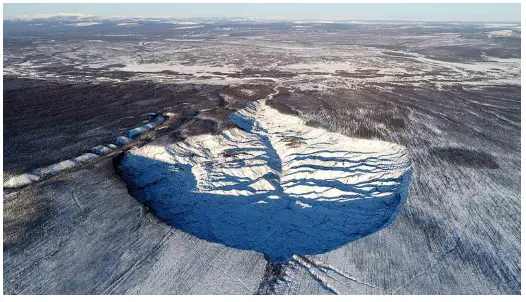
Unveiling the Mysteries of Batagay Crater
- Known as the "gateway to the underworld," Batagay Crater is situated in Russia's Sakha Republic and is renowned for being the world's largest permafrost crater.
- Initially identified in 1991 through satellite imagery, the crater, also referred to as a megaslump, features a distinctive rounded cliff face.
- Its formation is attributed to the thawing of permafrost, which had been frozen since the Quaternary Ice Age approximately 2.58 million years ago, according to scientific consensus.
- Permafrost, defined as ground that remains frozen at or below 32°F (0°C) for a minimum of two consecutive years, is widespread across Earth's high-latitude regions, particularly near the poles and in mountainous areas.
- It covers a significant portion of the planet's surface, with nearly one-quarter of the Northern Hemisphere's land area containing permafrost beneath the surface.
Source: WION
The United Nations Counter-Terrorism Trust Fund
In News: Recently, India reaffirmed its unwavering commitment to the global fight against terrorism by contributing $500,000 to the UN Counter-Terrorism Trust Fund.
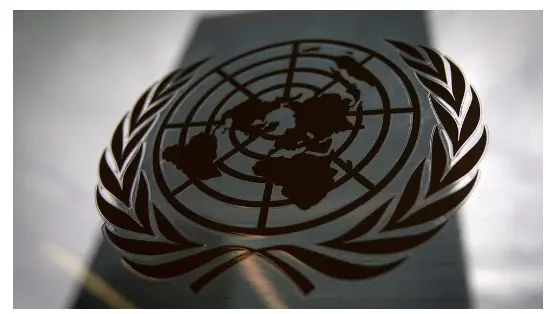
About The United Nations Counter-Terrorism Trust Fund
- The United Nations Counter-Terrorism Trust Fund was established in 2009 and transferred to the UN Office of Counter-Terrorism (UNOCT) in 2017.
- It accepts contributions from Governments, inter-governmental and non-governmental organizations, private institutions, and individuals.
- Contributions may be unearmarked or earmarked for specific initiatives.
- India's contribution primarily supports UNOCT's global programmes.
- These programmes focus on Countering Financing of Terrorism (CFT) and the Countering Terrorist Travel Programme (CTTP).
- The aim is to strengthen the capacities of member states in eastern and southern Africa.
- The focus is on combating terrorism financing and preventing terrorist movement.
Functions
- Providing leadership on counter-terrorism mandates entrusted to the Secretary-General by the UN General Assembly.
- Enhancing coordination and coherence across Global Counter-Terrorism Coordination Compact entities to ensure balanced implementation of the four pillars of the UN Global Counter-Terrorism Strategy.
- Strengthening the delivery of UN counter-terrorism capacity-building assistance to Member States.
- Improving visibility, advocacy, and resource mobilization for UN counter-terrorism efforts.
- Ensuring due priority is given to counterterrorism across the UN system and that efforts on preventing violent extremism are firmly rooted in the Strategy.
Source: TH
Non-market Economy Status and Anti-Dumping Duties
In News: Vietnam has been urging the President of the United States of America to promptly transition its classification from "non-market economy" to "market economy" status.
Understanding Non-market Economy Status and Anti-Dumping Duties
- The United States of America determines a country's non-market economy status based on various factors.
- These factors include the convertibility of the country's currency, wage rate determination through free bargaining, allowance of joint ventures or foreign investment, state ownership of means of production, and state control over resource allocation, prices, and output decisions.
- Other factors such as human rights may also be considered in this determination.
- Designating a country as a non-market economy allows the US to impose "anti-dumping" duties on goods imported from these countries.
- A market economy operates based on the interactions of consumers and businesses, with production decisions and prices determined by the law of supply and demand.
- Entrepreneurs in a market economy have the freedom to pursue profits by creating new products and the freedom to fail if they misjudge market demand.
- Anti-dumping duty is a tariff imposed on imports from foreign countries that are priced below the fair market value of similar goods in the domestic market.
- Governments impose anti-dumping duties when they believe foreign goods are being "dumped" into the domestic market at low prices, aiming to protect local businesses and markets from unfair competition.
Source: IE
Maillard Reaction
In News: The Maillard Reaction elucidates the intricate chemical processes responsible for the flavors, aromas, and textures found in foods.

Understanding the Maillard Reaction in Food Browning
The Maillard reaction, named after French scientist Louis-Camille Maillard, is a chemical process occurring when amino acids and sugars are heated, impacting the flavors, aromas, and textures of foods. It's a form of non-enzymatic browning where color change happens without enzyme activity.
Explanation of the Maillard Reaction
- Chemist J.E. Hodge in 1953 broke down the reaction into steps for simplification.
- When heated, sugars and proteins in foods undergo a condensation reaction, forming an unstable Schiff base.
- Rearrangement and dehydration of the Schiff base lead to various intermediate compounds, contributing to flavor development and aroma.
- Some intermediates undergo rearrangement, forming more stable products and precursors for melanoidins, responsible for food's brown color.
- Further changes like condensation and polymerization result in the formation of melanoidins.
Factors Influencing the Reaction
- Rate and extent depend on temperature, acidity, moisture content, and types and concentrations of proteins and sugars.
- Ideal temperatures range from 110°C to 170°C; higher temperatures can lead to burning and bitter flavors.
- Higher temperatures accelerate the reaction, while acidic conditions and water presence can inhibit it.
- Foods brown more quickly at higher temperatures, and dry foods like bread crusts develop deep brown colors during baking.
Source: TH
The Hindon River
In News: NGT directed UPPCB to submit a report on Hindon River pollution within two weeks, focusing on actions against offending municipal bodies.
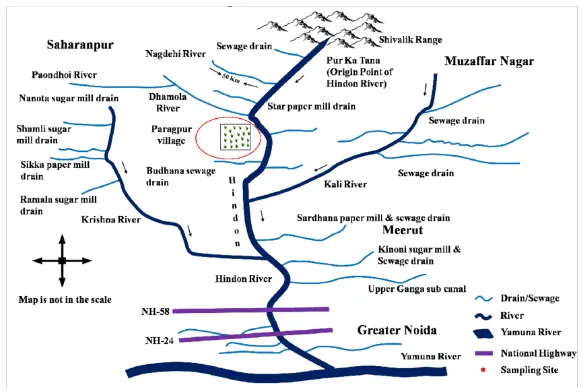
The Hindon River: Overview and Pollution Concerns
- The Hindon River serves as a tributary of the Yamuna River and predominantly relies on rainfall for its water source.
- Originating from the lower Shivalik ranges in Saharanpur District of Uttar Pradesh, it traverses approximately 400 kilometers through the industrial belt of Western Uttar Pradesh before merging with the Yamuna River in Noida.
- Noteworthy tributaries of the Hindon include the Kali (West) River and Krishni River.
- Despite its natural significance, the Hindon River faces severe pollution due to the discharge of untreated urban, agricultural, and industrial waste into its waters.
- This pollution has rendered the Hindon one of the most contaminated stretches within the Ganga basin.
- In 2015, the Central Pollution Control Board (CPCB) classified the Hindon as a 'dead river' and deemed it 'unfit' even for bathing in several sections.
Understanding the National Green Tribunal (NGT)
- Established under the National Green Tribunal Act 2010, the NGT is entrusted with the responsibility of ensuring effective and expedited resolution of cases pertaining to environmental protection and conservation of forests and natural resources.
- Its mandate dictates the swift disposal of applications or appeals within six months of filing.
- Comprising the Chairperson, Judicial Members, and Expert Members, the NGT primarily operates from New Delhi, with additional sitting locations in Bhopal, Pune, Kolkata, and Chennai.
- While the NGT is not bound by the procedural regulations outlined in the Code of Civil Procedure, 1908, it is guided by principles of natural justice.
- Additionally, the NGT holds appellate jurisdiction to adjudicate appeals akin to a Court.
Source: TP
Carbon Farming: A Pathway to Sustainable Agriculture
In News: A recent article discusses various methods under carbon farming aimed at mitigating greenhouse gas emissions and highlights the challenges associated with implementing these techniques, particularly in developing nations like India.
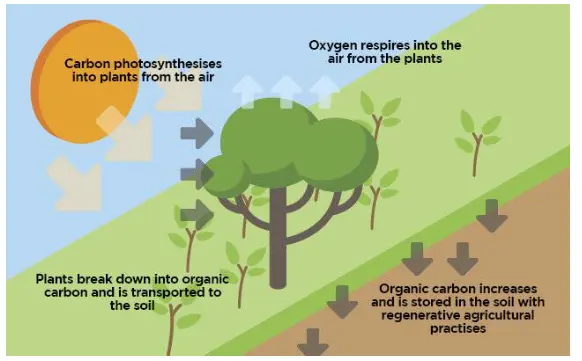
Introduction to Carbon Farming
- Carbon farming aims to maximize carbon sequestration through agricultural practices.
- It involves enhancing carbon absorption in plant biomass and soil organic matter.
- Careful planning, monitoring, and adaptation are essential for effectiveness.
Significance of Carbon Farming
- Climate Change Mitigation: Crucial for reducing greenhouse gas emissions.
- Soil Health Enhancement: Improves soil quality, water retention, and crop yields.
- Biodiversity Enrichment: Fosters diverse ecosystems and reduces pesticide use.
- Economic Opportunities: Opens avenues for income diversification for farmers.
Techniques in Carbon Farming
- Forest Management: Avoiding deforestation, reforestation, and improved forest practices.
- Agroforestry: Combining trees with agriculture for carbon sequestration.
- Grasslands Conservation: Protecting native vegetation to absorb greenhouse gases.
- Renewable Energy Production: Generating carbon offsets through renewable energy.
- Conservation Agriculture Techniques: Practices like zero tillage and cover cropping.
- Rotational Grazing: Managing livestock to promote vegetation regrowth.
Potential Opportunities for Carbon Farming in India
- Economic Opportunity: Significant potential for income generation in agriculture.
- Carbon Credit Systems: Farmers can benefit from carbon trading markets.
- Regional Suitability: Different regions offer varying potential for carbon farming.
Challenges Associated with Carbon Farming
- Soil Composition: Some soils may have limited carbon storage capacity.
- Geographic Location: Factors like elevation and proximity to water impact farming.
- Varieties of Crops: Selection of suitable crop varieties is crucial.
- Water Scarcity: Limited water availability can hinder carbon sequestration.
- Financial Constraints: Small-scale farmers may struggle with initial costs.
- Limited Policy Support: Lack of supportive policies hampers adoption.
Strategies to Encourage Carbon Farming
- Legal Framework: Enactment of comprehensive carbon farming legislation.
- Incentives for Farmers: Direct support for adopting climate-friendly practices.
- Utilizing Carbon Credits: Rewarding farmers with tradable carbon credits.
- Collective Engagement: Collaboration between stakeholders for scalability.
- Unlocking Soil Potential: Harnessing soil's capacity as a carbon sink for decarbonization.
|
UPSC Previous Year Questions Prelims (2018) Q. Which of the following statements best describes "carbon fertilisation"? (a) Increased plant growth due to increased concentration of carbon dioxide in the atmosphere. (b) Increased temperature of Earth due to increased concentration of carbon dioxide in the atmosphere. (c) Increased acidity of oceans as a result of increased concentration of carbon dioxide in the atmosphere. (d) Adaptation of all living beings on Earth to the climate change brought about by the increased concentration of carbon dioxide in the atmosphere. Ans: (a) Prelims (2020) Q.2 Which one of the following statements best the term ‘Social Cost of Carbon’? It is a measure, in monetary value, of the - (a) long-term damage done by a tonne of CO2 emissions in a given year. (b) requirement of fossil fuels for a country to provide goods and services to its citizens, based on the burning of those fuels. (c) efforts put in by a climate refugee to adapt to live in a new place. (d) contribution of an individual person to the carbon footprint on the planet Earth. Ans: (a) |
Source: TH
Practice Questions - Current Affairs 11-05-2024
Q1. Consider the following statements regarding the report on Direct Tax Collection
Statement-I: India's net direct tax collections surged by 17.7% in 2023-24, reaching Rs.19.58 lakh crores, with increased personal income taxes contributing 53.3% of total taxes.
Statement-II: The dip in corporate tax contribution is attributed to diminishing corporate tax shares since the deep tax cuts introduced in September 2019.
Select the correct answer using code given below:
Both Statement-I and Statement-II are correct and Statement-II is the correct explanation for Statement-I
Both Statement-I and Statement-II are correct and Statement-II is not the correct explanation for Statement-I
Statement-I is correct but Statement-II is incorrect
Statement-I is incorrect but Statement-II is correct
Q2. Consider the following statements regarding the significance of MSMEs in India
1. MSMEs contribute approximately 27.0% to India's GDP and account for more than 11 crore jobs.
2. The majority (90%) of MSME funding comes from formal sources.
3. The MSME sector lacks integration of digital technologies, hindering its transition to a circular and low-carbon economy.
How many of the statements given above are correct?
Only one
Only two
All three
None
Q3. Consider the following statements regarding the MQ-9B Predator
1. The MQ-9B Predator is primarily designed for civilian applications, such as agricultural monitoring and environmental surveys.
2. The MQ-9B Predator includes two variants: Sky Guardian and Sea Guardian, with the latter being utilized by the Indian Navy since 2020.
Which of the statements given above is/are correct?
1 Only
2 Only
Both 1 and 2
Neither 1 nor 2
Q4. Consider the following statements regarding the Mullaperiyar Dam
1. The Mullaperiyar dam is located at the confluence of the Mullayar and Periyar rivers entirely within Kerala.
2. The safety concerns regarding the Mullaperiyar Dam arose in 1979 following reports of minor earthquakes causing cracks in the dam.
3. The Dam Safety Act, enacted in December 2021, aims to address safety concerns of major dams nationwide, covering surveillance, inspection, operation, and maintenance.
How many of the statements given above are correct?
Only one
Only two
All three
None
Q5. With reference to drip pricing, consider the following statements:
1. Drip pricing involves the upfront disclosure of all additional charges associated with a product or service.
2. Drip pricing is commonly employed in industries like hospitality, travel, and online payments.
Which of the statements given above is/are not correct?
1 Only
2 Only
Both 1 and 2
Neither 1 nor 2
Q6. Consider the following statements regarding carbon farming:
Statement I: Carbon farming involves agricultural practices aimed at storing carbon in various natural reservoirs to mitigate climate change.
Statement II: Agroforestry is not a suitable method for carbon farming as it does not contribute to carbon sequestration.
Select the correct answer using code given below:
Both Statement-I and Statement-II are correct and Statement-II is the correct explanation for Statement-I
Both Statement-I and Statement-II are correct and Statement-II is not the correct explanation for Statement-I
Statement-I is correct but Statement-II is incorrect
Statement-I is incorrect but Statement-II is correct
Q7. Consider the following statements regarding the benefits to tobacco farmers in Andhra Pradesh:
1. Tobacco farmers in Andhra Pradesh are experiencing a significant surge in auction prices, attributed to crop damage in Brazil and Zimbabwe.
2. China has imposed limitations on tobacco exports, which have contributed to the price escalation in India.
3. The surge in tobacco prices is expected to provide long-term benefits to Indian growers due to sustained favorable pricing conditions.
How many of the statements given above are correct?
Only one
Only two
All three
None
Q8. Consider the following statements regarding Choline
1. Choline is not an essential nutrient and have a minimal function in controlling the rate of the metabolism in humans and animals.
2. Our body can produce choline nutrient.
Which of the statements given above is/are correct?
1 Only
2 Only
Both 1 and 2
Neither 1 nor 2
Q9. Consider the following statements regarding rat-hole mining:
1. Rat-hole mining is primarily practiced in Meghalaya, India.
2. The demand for coal drives rat-hole mining, facilitated by middlemen and illegal traders.
3. Rat-hole mining is permitted under Nagaland's coal mining policy, with licenses granted to individual landowners under specific conditions.
How many of the statements given above are correct?
Only one
Only two
All three
None
Q10. With reference to Fusobacterium nucleatum and its role in colorectal tumors, consider the following statements:
1. Fusobacterium nucleatum is exclusively found in the oral cavity and is not present in the gastrointestinal tract.
2. Genetic analysis revealed that only one subspecies of Fusobacterium nucleatum, termed Fna C2, was consistently present in colorectal tumor samples.
Which of the statements given above is/are not correct?
1 Only
2 Only
Both 1 and 2
Neither 1 nor 2
Q11. Consider the following statements regarding Artificial General Intelligence (AGI):
Statement-I: AGI represents a highly advanced form of intelligence surpassing conventional Artificial Intelligence (AI).
Statement-II: AGI aims for a broader, generalized form of intelligence, transcending specific tasks, and exhibiting characteristics such as generalization, complex reasoning, learning, self-awareness, and consciousness.
Select the correct answer using code given below:
Both Statement-I and Statement-II are correct and Statement-II is the correct explanation for Statement-I
Both Statement-I and Statement-II are correct and Statement-II is not the correct explanation for Statement-I
Statement-I is correct but Statement-II is incorrect
Statement-I is incorrect but Statement-II is correct
Q12. Consider the following statements regarding The Explosives Act
1. The Explosives Act of 1884 is a crucial piece of Indian legislation that governs the manufacture, possession, use, sale, transportation, import, and export of explosives in India.
2. The Act empowers the State Government to make rules regulating the manufacture, possession, use, sale, transport, import, and export of explosives
3. The Central Government can prohibit the manufacture, possession, or importation of especially dangerous explosives in the interest of public safety
How many of the statements given above are correct?
Only one
Only two
All three
None
Q13. Consider the following statements regarding Central Bank digital currencies
1. It is possible to make payments in a digital currency without using US dollar or SWIFT system.
2. A digital currency can be distributed with condition programmed into it such as a time-frame for spending it
Which of the statements given above is/are correct?
1 Only
2 Only
Both 1 and 2
Neither 1 nor 2
Q14. Consider the following statements regarding Central Drugs Standard Control Organisation (CDSCO)
1. The Central Drugs Standard Control Organisation (CDSCO) functions as the National Regulatory Authority (NRA) in India for the medical devices industry, operating under the provisions of the Drugs and Cosmetics Act
2. The CDSCO operates under the Directorate General of Health Services, which falls under the Ministry of Health & Family Welfare of the Government of India Central Drugs Standard Control Organisation is headquartered in Navi Mumbai.
How many of the statements given above are correct?
Only one
Only two
All three
None
Q15. With reference to Shinkun La Tunnel and Border Roads Organisation consider the following statements
1. The Shinkun La Tunnel is an upcoming motorable passage situated beneath the 16,580 feet high Shinku-La pass, linking Himachal’s Lahaul valley and Ladakh’s Shyok valley.
2. BRO was established on May 7, 1960, its primary objectives include securing India's borders and developing infrastructure in remote regions of the northern and northeastern states.
Which of the statements given above is/are not correct?
1 Only
2 Only
Both 1 and 2
Neither 1 nor 2
Q16. Consider the following statements regarding India's Pharmaceutical Industry:
Statement-I: India has transitioned to self-sufficiency in medical consumables and disposables and is the largest global manufacturer of generic medicines.
Statement-II: The industry is valued at USD 50 billion and serves over 200 countries, with projections to reach USD 65 billion by 2024 and USD 130 billion by 2030.
Select the correct answer using code given below:
Both Statement-I and Statement-II are correct and Statement-II is the correct explanation for Statement-I
Both Statement-I and Statement-II are correct and Statement-II is not the correct explanation for Statement-I
Statement-I is correct but Statement-II is incorrect
Statement-I is incorrect but Statement-II is correct
Q17. Consider the following statements regarding Centre's Plea on CBI Probes' Maintainability:
1. West Bengal filed a suit under Article 131, accusing the Union government of unauthorized CBI investigations within the state.
2. The Centre argues for the suit's dismissal, denying involvement in CBI investigations within states and claiming that CBI isn't a 'state' under Article 131.
3. The Supreme Court highlights Section 5(1) of the DSPE Act, granting the central government authority over CBI investigations across states.
How many of the statements given above are correct?
Only one
Only two
All three
None
Q18. Consider the following statements regarding AlphaFold3
1. AlphaFold3 can predict the structure and interactions of all molecules with unprecedented accuracy, excluding human DNA.
2. AlphaFold3 assembles its predictions using a diffusion network, a technique reminiscent of those employed in AI image generators
Which of the statements given above is/are correct?
1 Only
2 Only
Both 1 and 2
Neither 1 nor 2
Q19. Consider the following statements regarding Constructed Wetlands:
1. Constructed wetlands are human-made systems designed to mimic natural wetland processes for wastewater treatment, utilizing vegetation, soil, and water interactions.
2. Surface Flow (SF) constructed wetlands involve passing wastewater through gravel beds or porous media underground, where microbial activity breaks down organic matter.
3. Constructed wetlands are not cost-effective compared to traditional treatment methods due to high construction and maintenance costs.
How many of the statements given above are correct?
Only one
Only two
All three
None
Q20. With reference to Glide Phase Interceptor (GPI) Project consider the following statements
1. The Glide Phase Interceptor (GPI) Project is a collaborative effort between the United States and Japan to develop a missile-intercepting system.
2. Hypersonic weapons fly at relatively low altitudes (20 to 80 km) during the glide phase.
Which of the statements given above is/are not correct?
1 Only
2 Only
Both 1 and 2
Neither 1 nor 2
Share the article
Edukemy’s Current Affairs Quiz is published with multiple choice questions for UPSC exams
MCQ
Get Latest Updates on Offers, Event dates, and free Mentorship sessions.

Get in touch with our Expert Academic Counsellors 👋
FAQs
UPSC Daily Current Affairs focuses on learning current events on a daily basis. An aspirant needs to study regular and updated information about current events, news, and relevant topics that are important for UPSC aspirants. It covers national and international affairs, government policies, socio-economic issues, science and technology advancements, and more.
UPSC Daily Current Affairs provides aspirants with a concise and comprehensive overview of the latest happenings and developments across various fields. It helps aspirants stay updated with current affairs and provides them with valuable insights and analysis, which are essential for answering questions in the UPSC examinations. It enhances their knowledge, analytical skills, and ability to connect current affairs with the UPSC syllabus.
UPSC Daily Current Affairs covers a wide range of topics, including politics, economics, science and technology, environment, social issues, governance, international relations, and more. It offers news summaries, in-depth analyses, editorials, opinion pieces, and relevant study materials. It also provides practice questions and quizzes to help aspirants test their understanding of current affairs.
Edukemy's UPSC Daily Current Affairs can be accessed through:
- UPSC Daily Current Affairs can be accessed through Current Affairs tab at the top of the Main Page of Edukemy.
- Edukemy Mobile app: The Daily Current Affairs can also be access through Edukemy Mobile App.
- Social media: Follow Edukemy’s official social media accounts or pages that provide UPSC Daily Current Affairs updates, including Facebook, Twitter, or Telegram channels.


